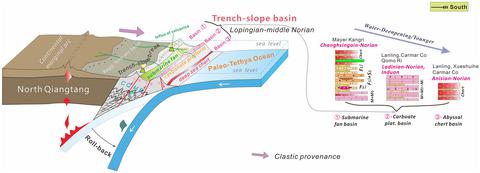当前位置:
X-MOL 学术
›
Basin Res.
›
论文详情
Our official English website, www.x-mol.net, welcomes your
feedback! (Note: you will need to create a separate account there.)
A late Permian–Triassic trench-slope basin in the Central Qiangtang metamorphic belt, Northern Tibet: Stratigraphy, sedimentology, syndepositional deformation and tectonic implications
Basin Research ( IF 2.8 ) Pub Date : 2021-02-20 , DOI: 10.1111/bre.12561 Xiao Liang 1, 2 , Genhou Wang 1 , Jinhan Gao 1 , Haishui Jiang 3 , Guoli Yuan 1 , Dian Li 4 , Wentao Cao 2, 5 , Yilong Zheng 1 , Qiang Fang 1 , Byung‐Su Lee 6 , Soo‐In Park 6 , Yaxi Wang 1 , Jia Zhao 1
Basin Research ( IF 2.8 ) Pub Date : 2021-02-20 , DOI: 10.1111/bre.12561 Xiao Liang 1, 2 , Genhou Wang 1 , Jinhan Gao 1 , Haishui Jiang 3 , Guoli Yuan 1 , Dian Li 4 , Wentao Cao 2, 5 , Yilong Zheng 1 , Qiang Fang 1 , Byung‐Su Lee 6 , Soo‐In Park 6 , Yaxi Wang 1 , Jia Zhao 1
Affiliation

|
Records of sedimentation and deformation in trench-slope basins contain valuable tectonic information about the associated oceanic subduction zone. Here, we present a multidisciplinary study on newly discovered late Permian–Triassic sedimentary successions in the >500-km-long Central Qiangtang metamorphic belt (CQMB) to better understand the type of basin and the concomitant tectonism. The Mayer Kangri succession contains lithofacies associations of submarine fan siliciclastic rocks, slope-environment limestone, deep marine chert and minor olistostromes from the forearc basin. The conodont assemblages and sandstone and andesite interlayers yield continuous stratigraphic ages from the Lopingian to middle Norian. The clastic sediments had two provenances, including the epicontinental arc in the North Qiangtang block (NQB) and synchronous volcanism in the accretionary wedge. Moreover, a large suite of the Anisian–early Carnian radiolarian cherts (>30 m thick) was discovered in the Lanling area. Regionally, the CQMB shows evident spatiotemporal variations in late Permian–Triassic sedimentation, with a general depositional trend of southward deepening and getting younger. The three identified subzones include a bathyal setting, a carbonate platform setting and a deep marine setting from north to south. These observations indicate that the late Permian–Triassic sedimentary successions in the CQMB were deposited in a trench-slope basin environment during the northward subduction of the Longmu Co–Shuanghu Tethys Ocean beneath the NQB. Generally, the CQMB and the concomitant trench-slope basin is among the well-preserved ancient analogs characterized by extensional tectonism. The syndepositional horst-graben-like structure, forearc basin-derived olistostromes, abyssal radiolarian cherts and synchronous volcanism provide new implications for the geological evolution of the trench-slope basin.
中文翻译:

藏北羌塘变质带中晚二叠世-三叠纪沟坡盆地:地层学、沉积学、同沉积变形及构造意义
海沟斜坡盆地的沉积和变形记录包含有关相关海洋俯冲带的宝贵构造信息。在这里,我们对超过 500 公里长的中央羌塘变质带 (CQMB) 中新发现的晚二叠纪-三叠纪沉积序列进行了多学科研究,以更好地了解盆地类型和伴随的构造作用。Mayer Kangri 层序包含海底扇硅质碎屑岩、斜坡环境石灰岩、深海燧石和弧前盆地的少量滑石的岩相组合。牙形石组合和砂岩和安山岩夹层产生了从洛平阶到中诺阶的连续地层时代。碎屑沉积物有两个来源,包括北羌塘地块(NQB)的陆缘弧和增生楔中的同步火山作用。此外,在兰陵地区还发现了一大套 Anisian-early Carnian 放射虫燧石(>30 m 厚)。从区域上看,青藏高原晚二叠世—三叠世沉积时空变化明显,总体沉积趋势向南加深、年轻化。确定的三个亚带从北到南包括深海环境、碳酸盐台地环境和深海环境。这些观测表明,在龙木错-双湖特提斯洋向北俯冲期间,青藏高原晚二叠世-三叠世沉积序列沉积在海沟-斜坡盆地环境中。一般来说,CQMB 和伴随的海沟斜坡盆地是保存完好的以伸展构造为特征的古代类似物之一。同沉积地堑状构造、弧前盆地衍生的滑石、深海放射虫硅质岩和同步火山作用为海沟斜坡盆地的地质演化提供了新的意义。
更新日期:2021-02-20
中文翻译:

藏北羌塘变质带中晚二叠世-三叠纪沟坡盆地:地层学、沉积学、同沉积变形及构造意义
海沟斜坡盆地的沉积和变形记录包含有关相关海洋俯冲带的宝贵构造信息。在这里,我们对超过 500 公里长的中央羌塘变质带 (CQMB) 中新发现的晚二叠纪-三叠纪沉积序列进行了多学科研究,以更好地了解盆地类型和伴随的构造作用。Mayer Kangri 层序包含海底扇硅质碎屑岩、斜坡环境石灰岩、深海燧石和弧前盆地的少量滑石的岩相组合。牙形石组合和砂岩和安山岩夹层产生了从洛平阶到中诺阶的连续地层时代。碎屑沉积物有两个来源,包括北羌塘地块(NQB)的陆缘弧和增生楔中的同步火山作用。此外,在兰陵地区还发现了一大套 Anisian-early Carnian 放射虫燧石(>30 m 厚)。从区域上看,青藏高原晚二叠世—三叠世沉积时空变化明显,总体沉积趋势向南加深、年轻化。确定的三个亚带从北到南包括深海环境、碳酸盐台地环境和深海环境。这些观测表明,在龙木错-双湖特提斯洋向北俯冲期间,青藏高原晚二叠世-三叠世沉积序列沉积在海沟-斜坡盆地环境中。一般来说,CQMB 和伴随的海沟斜坡盆地是保存完好的以伸展构造为特征的古代类似物之一。同沉积地堑状构造、弧前盆地衍生的滑石、深海放射虫硅质岩和同步火山作用为海沟斜坡盆地的地质演化提供了新的意义。











































 京公网安备 11010802027423号
京公网安备 11010802027423号